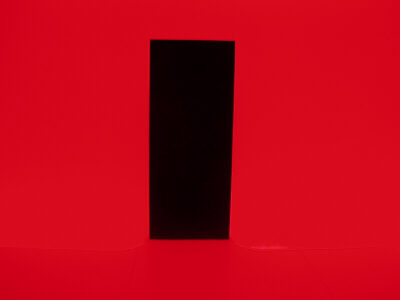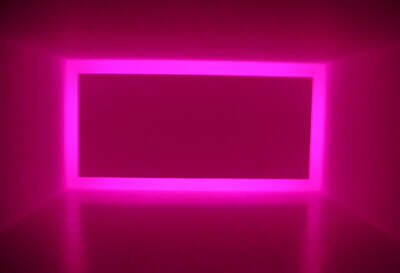 Jay Michaelson
Jay MichaelsonWhat Turrell offers, however, is what art at its most profound should offer: a re-visioning of consciousness itself. Merely decorative art provides us with pleasant furnishings for our existing mental homes. Transformative art offers a different architecture. Sometimes this re-visioning is closely linked to a particular theory of perception (Seurat, Picasso/Braque, Baer, Turrell); sometimes it changes our experience of supposedly 'non-art' reality into an aesthetic moment (Cage, Warhol, Duchamp, conceptual art); sometimes art captures the poetry of moments that are otherwise so transitory as to escape notice entirely (Vermeer, Brueghel) or so sublime/terrible that they are reminders of the transcendent (German Romanticism, Picasso, Delacroix). And some art works purely symbolically-psychologically, involving our deep, emotional selves in a visual experience (Rothko, Pollock). In all of these cases, art is a form of contemplative practice, taking us out of mundane consciousness and into a mind-state in which the conventions of the quotidian may be seen as the contingent ephemera that they are. Even when art seems to lose itself in theory, its essential newness means that the boundaries of experience are forever being expanded. Definitions are always inadequate; the numinous is always evoked.
Most overtly 'spiritual' art is less than this. Typically, it more
closely resembles a cliched repetition of 'spiritual' imagery: visual
cues from religious traditions, symbolic structures from mysticism. Its experience is
secondary. We respond to these cues (if at all) not because they embody the numinous but merely
because they refer to it: an angel means God's protection,
a chakra-map means holistic health. Turrell's art, however, directly
presents the numinous for our attention. There is not a trace of any
particular religious or philosophical language in the works themselves.
 Consider Rise, a room with, at one end, a light source hidden
behind an opaque rectangular 'wall.' From around the edges of the wall,
light emanates, slowly changing in tone from red to purple to blue and back.
Turrell speaks of Rise and other works in the terms of Plato's Cave,
but he is not creating a diorama of the Cave so much as presenting
the object of insight itself for our consideration. As such, Turrell's
is a more direct - and thus more mystical - art than those which merely
quote the language of religion. Where such art, like religion, speaks of
Being, Turrell's, like mysticism, invites us to experience it directly.
Consider Rise, a room with, at one end, a light source hidden
behind an opaque rectangular 'wall.' From around the edges of the wall,
light emanates, slowly changing in tone from red to purple to blue and back.
Turrell speaks of Rise and other works in the terms of Plato's Cave,
but he is not creating a diorama of the Cave so much as presenting
the object of insight itself for our consideration. As such, Turrell's
is a more direct - and thus more mystical - art than those which merely
quote the language of religion. Where such art, like religion, speaks of
Being, Turrell's, like mysticism, invites us to experience it directly.
This is why viewing Rothko is a more religious experience than pondering a depiction of the Passion; art presents that reality of which the Passion narrative is meant to remind us.
Turrell's scientific theoretical language is in tension with the contemplative use of his art only if we suppose the numinous to yield only one vocabulary. In fact, avoiding religion-talk is the best way to talk about the object of religion. Really, the attention to perceptual-scientific detail cannot be in tension with this contemplative process: it is a refined manifestation of its truth. The Buddha is not vague; It is what is, in all the precise details. Likewise, Turrell's perceptual psychology is not the portal to some other 'spiritual' experience which then takes place in a fuzzy realm of emotional excitement; it is spiritual experience itself. This is how motorcycle maintenance is a Buddhist path, and "mountains are once again mountains" at the end of the Zen quest. Turrell invites us to sit down, stop the mind's ordinary processing of perception, and notice the "truth in light itself." If that isn't contemplation of God, what is?

Dick Cheney and the New Age
March, 2003
...and what to do about it
February, 2003
Anxiety on the national mall
January, 2003
Arte Povera, Damien Hirst, and postmodernism
December, 2002
Pierre Bonnard at the Phillips
November, 2002
Being at one with Being
July, 2002
What's the difference between laughing with art and laughing at it?
June, 2002



Zeek in Print
Buy your copy today
Germanophobia
Michael Shurkin
The Red-Green
Alliance
Dave Hyde
The Art of
Enlightenment
Jay Michaelson
yom kippur
Sara Seinberg
Josh Plays the Sitar
Josh Ring
Genuine Authentic
Gangsta Flava
dan friedman
saddies
David Stromberg
about zeek
archive
links